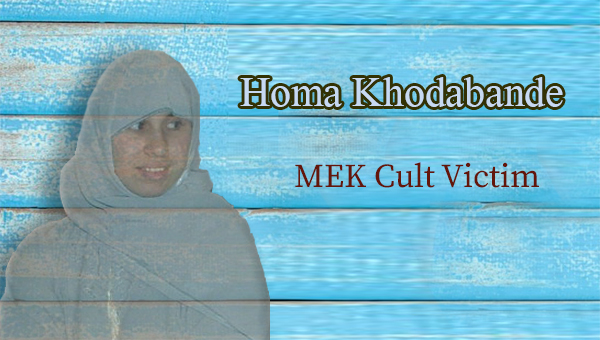Homa was born in Newcastle, UK in 1979, coinciding with the Iranian Revolution. Her father Ebrahim Khodabandeh was an active member of The Muslim Students’ Association abroad. In the summer of 1980, Ebrahim joined the Mujahedin Khalq Organization (the MKO/ MEK/ PMOI/ the Cult of Rajavi) that he had found Islamic, nationalistic and anti-Imperialist. When became a full time member of the group, he left his British wife and the one and a half year-old Homa.

Homa was eleven years old that got to know about her father. She saw her ID card for the first time. At school she wrote an essay about the father that she knew who he was but she did not know where he was.
Then, Homa’s grandmother took her to Baghdad, Iraq to meet her father. A few visit were made between the father and the girl but under the supervision of the MEK commanders. Homa left Iraq with tearful eyes because her father was not even able to accompany her to the airport.
During the following years, the group constantly asked Ebrahim to encourage her daughter to join the group. He was not allowed to visit Homa except with the intention of bringing her to the group’s events but the father and her daughter were not willing to do so.
Once Ebrahim Khodabandeh was in Sweden, Homa was informed by her aunt Sudabeh Khodabandeh about the whereabouts of her father. She was 16 years old when her grandmother took her to Sweden to visit her father for a very short time, in the MEK’s base in Sweden.
Ebrahim was in Baghdad when he found out that the IRC office had a letter for him. He could receive the letter only after he could convince the MEK commanders. Homa had written to his father that she was going to marry and had asked him to call her. When Ebrahim could manage to call her she was married with two children. This was the consequence of a longtime challenge between the IRC and the MEK leaders who did not want Ebrahim to keep in touch with her daughter.
When Ebrahim Khodabandeh was arrested in the Syrain border, the MEK authorities contacted Homa –who had just given birth to her third baby— telling her that her father was under torture in Iran and would be executed very soon. They asked her to take part in an anti-Iran demonstration in London. They even tried defiantly to convince her to set herself on fire in front of the Iranian embassy. She finally threatened them that she would call the police.
Homa who had only visited her father for a few short times, began to take legal actions to pursue the case of her father in Evin prison via the Iranian embassy in London. A year later, she traveled to Iran together with her husband and their three children. Before her departure for Iran, the MEK authorities called her and tried to stop her from going to Iran terrifying her of the government in Tehran.
However, in Tehran, Homa visited her father in Evin prison and then she met the Judge of the case trying to help her father. After she returned to Britain, she called the MEK to tell them about the situation of her father in Iran but they never answered her call.
Homa is now 42 years old, the mother of five children. She has a good life now but her memories of childhood are not pleasant to her. She always says: “Left with no letters or phone calls, it is so hard for a girl that she does not know where her father is, what he does”. However, the harder thing was the way the MEK treated her. The MEK wanted to abuse Homa on behalf of its own interests.
Homa was lucky that her grandmother supported her raising her an independent and vigilant girl. She is a pious Musli now and the manager of the educational institute that she has established herself. Her bigger son Soleiman is a Medical student, her second son Salaheddin is a mechanical engineering student, her daughter Saleheh goes to pre university school. Ebrahim and Mohammad, both students, are her younger children.
Nejat Society



